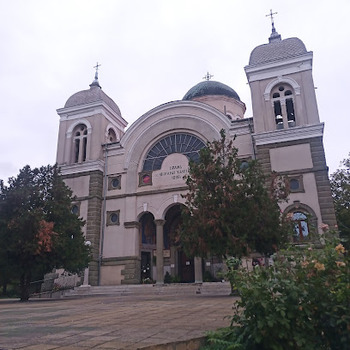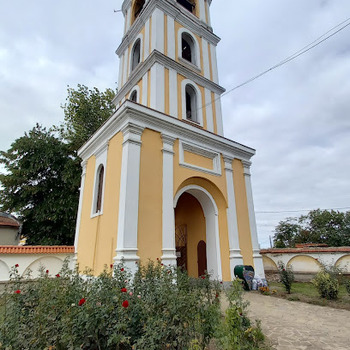Holy Trinity Church Yambol city
Overview
The beginning of the construction of the church "St. Trinity ”in Yambol we connect with the first centuries of Ottoman slavery and the creation of Cargona as a Bulgarian part of the city.
Yambol fell under Ottoman rule after a six-month siege in 1373. The conquest of the city and the region almost a quarter of a century earlier than the rest of the Bulgarian lands put the inhabitants of the city in a particularly unfavorable position. The people of Yambol are experiencing with the greatest force the shock wave of the foreign invasion.
The assimilation policy of the conqueror and the aspiration to establish domination over the conquered Bulgarians fell with all their weight and over their faith. Discrimination is carried out through: the destruction of churches and monasteries, the prohibition of building new ones, the conversion of temples into mosques, the persecution of the Christian clergy, the prohibition or restriction of church processes. From the second half of the 16th century all churches and monasteries in Yambol and Yambol region were already destroyed, according to researchers on the ruins of one of the churches in the Yambol fortress an impressive and impressive mosque was built - Sofularska. The memory of them remains only in the legends and toponymy of 36 settlements in the area.
There is no historical information about the original appearance of the Holy Trinity Church in Yambol. According to some authors from the 1930s, it resembles an early Christian catacomb.
The only material monument proving the existence of the church in the seventeenth century is the silver discus preserved in the fund of the Yambol Regional Historical Museum. It is a circle with a diameter of 190 mm. The footrest is missing. There is an inscription in a semicircle in Greek: “Prayer. Servant of God Alexi presents to the church "Holy Trinity 1692". There is no decoration on the discus, something typical of the church - ritual objects from the seventeenth century. We have no information where the discus was made. Its relatively early dating suggests that it be ordered and brought by one of the many taxi drivers from Mount Athos who visited Yambol. The name of the donor "Slave of God Alexi" draws attention to a group of wealthier Bulgarian leaders, who gradually established themselves and began to play a leading role in the public life of Bulgarians in Yambol. Maybe even the "servant of God Alexi" himself was a merchant - a worshiper who bought and donated to the temple this silver discus.
In his memoirs, Chernyo Georgiev from Yambol describes the original architectural appearance of the church "built at a depth of 50-60 cm in the ground and entered by 304 steps." The church was 7 meters wide and about 16 meters long. The whole building had no windows and was lit only by the flame of the wax candles, which the worshipers lit on two small iron candlesticks. The catacomb-type church had two almost equal compartments for men and women. The decoration of the church was also primitive - there were six icons on the iconostasis, and only a few saints and prophets were painted on the walls.
The existence of the Church of the Holy Trinity from the beginning of the 17th century suggests the visit of the Patriarch of Jerusalem Chrysanthemum Notary to Yambol in June 1720.
The purpose of the visit to Yambol, as well as to some other cities in the southern Bulgarian lands, is to raise funds for the monasteries of God's tomb. He describes this visit in a rather extensive travelogue. The patriarch arrived in Yambol on June 7, 1720 and remained here for almost a month. He settled in the Bulgarian quarter of Kargon / Karvuna / in the home of the Bozhigrobski deputy in Yambol, the priest from the other Bulgarian church in Kargona, Avram Lefteri. In his travelogue, the patriarch registered two parishes in the city: the one to the Holy Trinity Church and the other to the St. George Church, which he noted as larger. 228 people from Yambol from both parishes donate a pretty decent amount of money to support God's places. They are proof of the economic prosperity of the Yambol Christians, of the development of the guilds and trade in the town and of the dominant role of the Bulgarian ethnic group in Cargona.
And in the next eighteenth century the church "St. Trinity ”together with the church“ St. Georgi ”for the Christians of the city are the only public places where on weekdays and holidays of baptisms, weddings and funerals, fellow believers regularly gather, who seek and find support in the churches for their national and religious preservation.
They are the main places around which the struggles of the people of Yambol against the Greek clergy and influence are inflamed and developed.
Yambol residents have repeatedly persecuted Bishop Kiril of Edirne from their temples. The culmination of the struggle against Greek influence in the city was the action around Easter in 1862, when the bishop was once again expelled from the city. The churches opened and for the first time the priests performed the service in Bulgarian. In the Holy Trinity Church, the young people of Yambol even erased all Greek inscriptions on the walls and on the icons. Newspaper "Bulgaria" from May 21, 1862. He reports: "The young people of Yambol burned the Greek books because they are not needed, do not read in them in the church books and do not roll or tear to pieces, burned them. These young men have done a work pleasing to God and praiseworthy of men.
After the firman for the establishment of the Bulgarian Exarchate / 1871 / a new church with a large dome was built on the site of the old church. The Ustabashi who manages the construction is the famous master builder Tsanyu from Tryavna.
During the Russo-Turkish Liberation War of 1877-78, the temple was set on fire.
After the Liberation in 1884, the building of the now existing Holy Trinity Church was built.
There is also a cell school next to the Holy Trinity Church, but the date of its opening is unknown. It is known that for the first time in Yambol an attempt was made to introduce the Bulgarian language in education. This is the work of the monk-teacher Terapion, who came to Yambol on the way to Mount Athos and managed for his short stay in the city to introduce the Bulgarian language in the education in the cell school at the church "Holy Trinity".
Around 1870 for church overseer of the church "St. Trinity ”was elected Valcho Glavchev / known as epitrope Valcha /, on whose initiative every year on the feast of the Holy Spirit at the church a large church council is arranged.
This tradition in modern times is accepted as a holiday of the city of Yambol.
In the memories of the old people of Yambol, the Holy Trinity Church is known as the Great Church.
The church is a cultural monument of local significance.
Recommended
- Museum of Military Glory
- Bezisten-Yambol
- Borovets Forest Park - Yambol
- Ethnographic complex
- Eski Mosque
- The Church of St. Nicholas the Wonderworker and others


 Bulgarian
Bulgarian Romanian
Romanian


